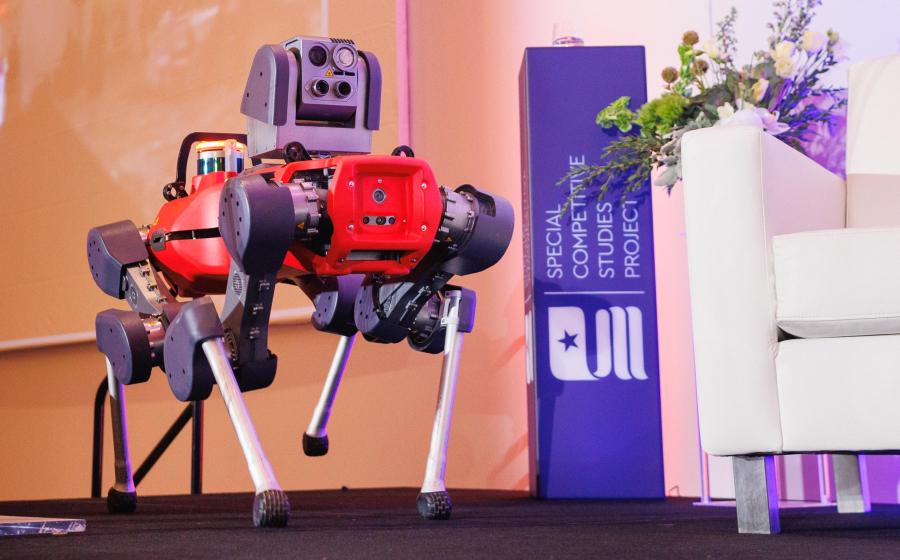Exchange of Emerging Technology Ideas Draws a Crowd in Cambridge
(NewsUSA) - Advances in technology, particularly in the areas of artificial intelligence (AI) are reshaping the geopolitical landscape. At the Ash Carter Exchange in Cambridge, Massachusetts, nearly 30 distinguished speakers discussed how emerging technologies are pushing the scientific frontier, transforming national security, and necessitating new partnerships between academic institutions, government agencies, and the private sector.
- Advances in technology, particularly in the areas of artificial intelligence (AI) are reshaping the geopolitical landscape. At the Ash Carter Exchange in Cambridge, Massachusetts, nearly 30 distinguished speakers discussed how emerging technologies are pushing the scientific frontier, transforming national security, and necessitating new partnerships between academic institutions, government agencies, and the private sector.
The event was hosted by the Special Competitive Studies Project (SCSP), a nonprofit and nonpartisan initiative with a goal of making recommendations to strengthen America's long-term competitiveness in AI.
The speakers stressed that achieving technological leadership requires not only investment in AI, biotechnology, and robotics, but also a unified effort across government, academia, and private industry to accelerate progress and transform traditional approaches.
Some key themes from the event included:
- Academic Evolution. Dr. Joseph E. Aoun, President of Northeastern University, emphasized the need to integrate AI as a fourth dimension of education alongside understanding the physical world, life, and social interactions. He also emphasized the need to shift from traditional education to lifetime learning, and the importance of producing more graduates in STEM fields that would support national security efforts.
- Emerging Technology Extension. Anne Neuberger, the Deputy Assistant to the President and Deputy National Security Advisor for Cyber and Emerging Technologies discussed the evolving role of cyber capabilities and emerging technologies in protecting national security. She emphasized the potential of AI to enhance both offensive operations and defensive capabilities, such as identifying vulnerabilities and detecting anomalies. However, she warned of the risks of AI models trained on non-assured code, and emphasized the challenge of deterrence in cyberspace, especially with regard to ransomware threats.
- Biotechnology and Robotics Revolution. Dr. Noubar Afeyan, founder and CEO of Flagship Pioneering and co-Founder of Moderna, highlighted the transformative role of AI in biotechnology, notably in generating protein sequences and antibodies to treat disease. The use of molecular markers for early disease detection could reduce healthcare costs and improve outcomes, he said. Although public-private partnerships have been essential to advancing technology, as in the case of the rapid development of a COVID-19 vaccine, Dr. Afeyan emphasized the need to guard against potential misuse of AI in biotechnology. Dr. Marc Raibert, Founder and Executive Director of the AI Institute, also discussed the evolution of robotics over the past 50 years, and reflected some of the issues raised at the SCSP’s recent AI+ Robotics Summit.
Overall, the message of the Ash Carter Exchange was clear: now is the time to align resources, reform outdated systems, and commit to collaborative progress if the United States is to uphold its strategic, technological, and ideological edge in the world.
Visit scsp.ai for more information, and the SCSP YouTube channel to watch sessions from the Ash Carter Exchange.



 - The United States is poised for global leadership in the area of AI and robotics as discussed at the
- The United States is poised for global leadership in the area of AI and robotics as discussed at the 
 - Seattle, WA – iLocal, Inc., a leader in website development and search engine optimization (SEO), announces its latest suite of services designed to help businesses maximize online visibility, increase customer engagement, and drive measurable growth. Known for its innovative digital solutions, iLocal, Inc. combines a personalized approach with industry-leading technology to deliver high-quality, fully optimized websites that rank well in search results and convert visitors into loyal customers.
- Seattle, WA – iLocal, Inc., a leader in website development and search engine optimization (SEO), announces its latest suite of services designed to help businesses maximize online visibility, increase customer engagement, and drive measurable growth. Known for its innovative digital solutions, iLocal, Inc. combines a personalized approach with industry-leading technology to deliver high-quality, fully optimized websites that rank well in search results and convert visitors into loyal customers. -
-  Three key areas of technology – internet platforms, advanced battery technologies, and next-gen networks – have shown shifts in positions of power between the United States and China in the last few years, according to
Three key areas of technology – internet platforms, advanced battery technologies, and next-gen networks – have shown shifts in positions of power between the United States and China in the last few years, according to 
 - Artificial intelligence (AI) creates many things, including
- Artificial intelligence (AI) creates many things, including 
 - As advances in artificial intelligence continue to transform the world, the integration of AI and robotics will have a significant impact on many areas, and will change both fields.
- As advances in artificial intelligence continue to transform the world, the integration of AI and robotics will have a significant impact on many areas, and will change both fields. 
 - As artificial intelligence technology grows stronger, what we known about the complexity of the human brain provides perspective to its development, according to experts at experts at the Special Competitive Studies Project (SCSP), a nonprofit and nonpartisan initiative with a goal of making recommendations to strengthen America's long-term competitiveness in AI.
- As artificial intelligence technology grows stronger, what we known about the complexity of the human brain provides perspective to its development, according to experts at experts at the Special Competitive Studies Project (SCSP), a nonprofit and nonpartisan initiative with a goal of making recommendations to strengthen America's long-term competitiveness in AI.
 - The United States leads the world in artificial intelligence (AI), but this edge is at risk without a solution to the energy crisis caused by data centers that power AI, onshore manufacturing, and rapid electrification
- The United States leads the world in artificial intelligence (AI), but this edge is at risk without a solution to the energy crisis caused by data centers that power AI, onshore manufacturing, and rapid electrification 
 - The U.S. economy remains dynamic and robust, but continued focus on advanced manufacturing is needed to cement U.S. leadership in industries of the future, according to experts at the
- The U.S. economy remains dynamic and robust, but continued focus on advanced manufacturing is needed to cement U.S. leadership in industries of the future, according to experts at the 
 - Threats to global stability continue to evolve to include greater use of artificial intelligence (AI) to promote disinformation, according to experts at the
- Threats to global stability continue to evolve to include greater use of artificial intelligence (AI) to promote disinformation, according to experts at the 
